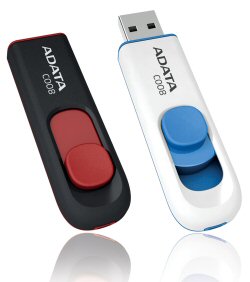- Details
- Flash Memory
Mach Xtreme Technology, a worldwide leader in top performance, high reliability and user-friendly designed PC components, today unveiled CX Series USB 2.0 flash drives. This eye-catching USB flash drive CX is the most convenient USB 2.0 flash drive designed for consumers who need significant storage capacity.

As PCs became increasingly powerful and able to process larger amounts of data, users needed to get more and more data into and out of their PCs. The MX-CX family of USB 2.0 are compact and reliable, making them ideal for transporting documents, photos, music, video files and more. MX-CX USB 2.0 flash drive requires no separate power cable and is fully plug and play. Mach Xtreme CX flash drive comes in 4GB, 8GB, 16GB and 32GB flavors.
- Details
- Flash Memory
ADATA Technology, the worldwide leader in DRAM modules and flash memory products, launched today the C008 retractable USB flash drive. The trendy design features a sliding USB connector, which smoothly extends from and retracts into the drive at the push of a thumb. The capless mechanical design eliminates the hassle of lost drive caps. Furthermore, users can effectively make the USB connector ready for use with just one hand, for greater convenience when speed is necessary.

The newly introduced C008 embodies both functionality and aesthetics. On one hand, the USB connector is concealed in the compact body, fully protected without the need for a drive cap. The matte-textured body is scratchproof and dirt-repellent. On the other hand, the C008 comes in an elegant shape and in two color schemes, expressing its unique personality. The simple curves of this series give a feeling of fashionable comfort. Additionally, the C008 is conveniently designed with a strap hole so that one can easily loop a string through and connect to a keychain or a mobile phone.
- Details
- Flash Memory
Mimoco, maker of the pop-culture-infused collection of MIMOBOT® designer USB flash drives, announces its Star Wars™ MIMOBOT Series 6 lineup of character-based flash drives at Star Wars Celebration V. The four new characters – Yoda, Hoth Luke, Wampa and Snowtrooper -– and the joint 2010 San Diego Comic-Con and Celebration V exclusive, Lobot, are devoted to Star Wars: Episode V The Empire Strikes Back, which is celebrating its 30th anniversary. At Celebration V, the new ‘bots will be featured at Mimoco’s booth, #312.

Leading the charge is the last remaining Jedi Master, Yoda MIMOBOT. Awesome, he is. Protect your data, he can. Of course, every great teacher needs a student, so Luke Skywalker joins the series, dressed for the cold, frozen wasteland of Hoth. But while he’s on Hoth, the Wampa MIMOBOT emerges, a stealthy predator ready to attack anyone who tries to steal his data. The last new character of the bunch is Snowtrooper MIMOBOT. Specially-trained Stormtrooper infantry divisions, Snowtroopers wear customized armor to handle cold weather climate extremes. They look cool as they stay warm -- but since they’re Stormtroopers, they still can’t shoot straight.
- Details
- Flash Memory
 Viking Modular Solutions, a division of Sanmina-SCI Corporation, and leading manufacturer of innovative memory and flash solutions, today announced its Slim SATA SSD, a case-less, small form-factor and rugged SATA SSD, is available for immediate customer qualification.
Viking Modular Solutions, a division of Sanmina-SCI Corporation, and leading manufacturer of innovative memory and flash solutions, today announced its Slim SATA SSD, a case-less, small form-factor and rugged SATA SSD, is available for immediate customer qualification.
Viking Modular Solutions’ Slim SATA SSD is an embedded solid state drive solution that delivers outstanding performance in a standard form factor – and is less than half the size of a 2.5” SSD. With its 3Gb SATA II interface and sustained performance of up to 260 MB/s (megabytes per second), the Viking Modular Slim SATA SSD is ideal for telecommunications, gaming, embedded server & storage systems, field computing and defense & aerospace applications.
“With this optimized small form factor SSD, communications and embedded applications can realize the performance associated with full size SSDs,” said Adrian Proctor, vice president of marketing at Viking Modular. “Now, system designers can take advantage of an ideal combination of performance, capacity, power, size and cost.”
- Details
- Flash Memory
Seagate Technology, the world leader in hard disk drives and storage solutions, and Samsung Electronics, the world leader in advanced memory technology, today announced that they have entered into a joint development and licensing agreement.
Under the agreement, the two companies will jointly develop and cross-license related controller technologies for solid state drive (“SSD”) storage devices to attain the high levels of performance, reliability and endurance demanded by enterprise storage applications.
The joint development effort builds on the existing SSD capabilities of each company while combining Seagate’s leadership in enterprise storage technology with Samsung’s flash memory technology specific to 30 nanometer-class MLC NAND. The jointly developed controller will be utilized in Seagate’s enterprise-class SSDs.
“Seagate has long recognized that solid state technology has an important role to play in the comprehensive solutions the storage industry will deliver today and in the future, particularly in the enterprise market,” said Steve Luczo, Seagate chairman, president and CEO. “Today’s agreement with Samsung will help us bring a compelling set of SSD innovations to the enterprise storage market, with benefits that range from enhanced performance, endurance and reliability to cost and capacity improvements. Overall, this agreement with Samsung strengthens our SSD solutions strategy, and positions Seagate well as global demand for storage continues on its strong growth path.”

